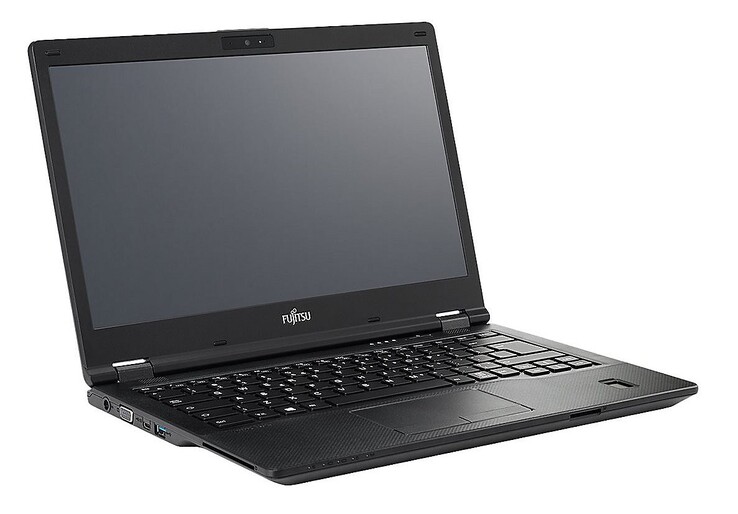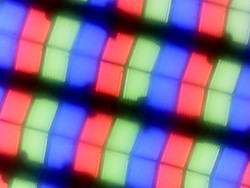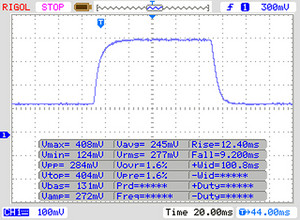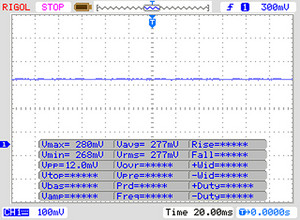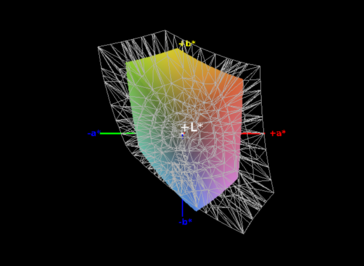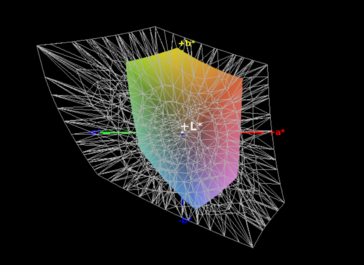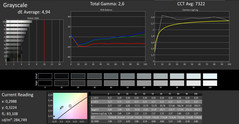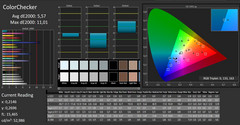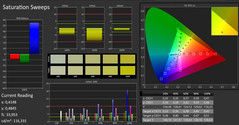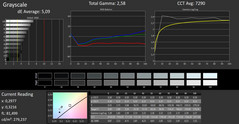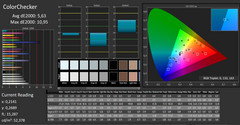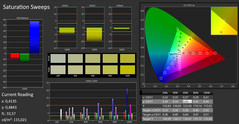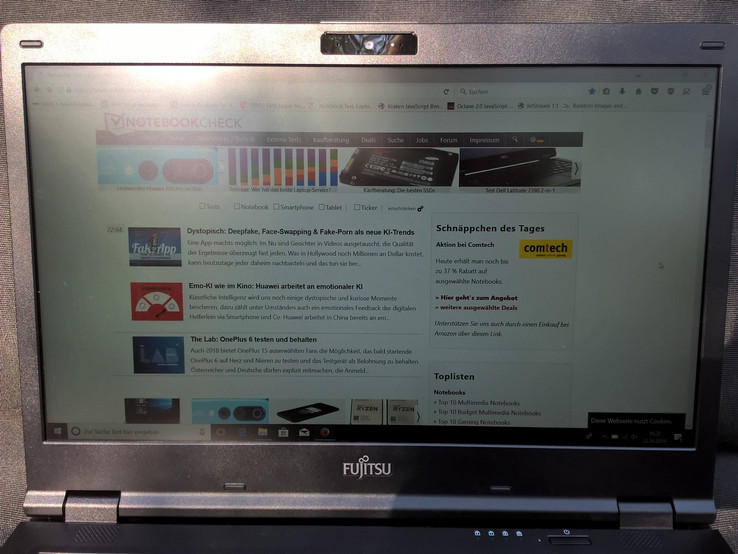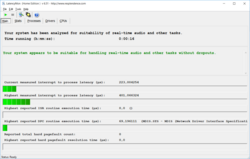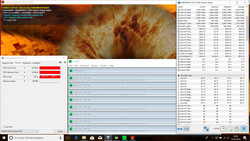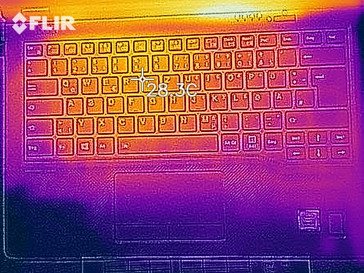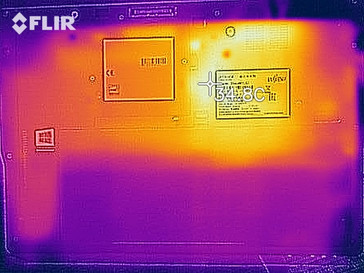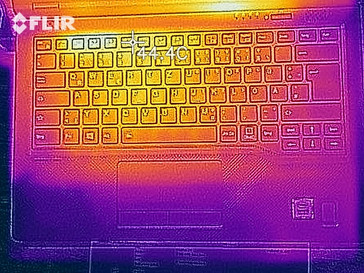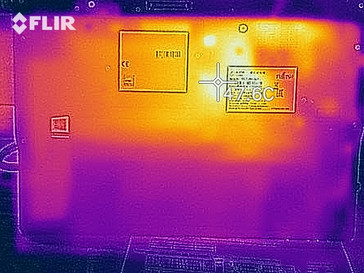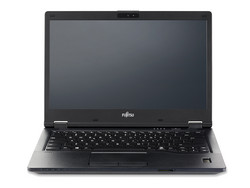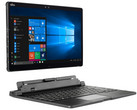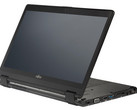Fujitsu LifeBook E548 (i5-8250U, UHD620) Laptop Review

With the notebooks of its E series, Fujitsu targets mobile office users who do not want to go without security and good maintenance options. Equipped with LTE, smart card reader, and an easily replaceable battery, most of the demands on mobility and security are already fulfilled. But in terms of performance as well, most of Fujitsu's LifeBooks can be adapted to all requirements through various configuration options. You can choose from among nine different Intel processors, which provide a suitable option for any budget.
Our test unit, the LifeBook E548, is equipped with an Intel Core i5-8250U processor and uses Intel UHD Graphics 620 for the display contents, and 8 GB of working memory and a 256 GB SSD round up the office package. Since the selection of 14-inch notebooks with this CPU is quite large, our LifeBook E548 has to face similarly equipped laptops in our test.
We are comparing the Fujitsu E548 with notebooks that are equipped with the same CPU/GPU combination. Our comparison devices include the Schenker Slim 14, the Lenovo ThinkPads E480 and L480, the Asus VivoBook S14, and the HP EliteBook 840 G5. Since the price level varies between 600 and 1500 Euros (~$732-1831), this offers a good comparison of the expected performance and equipment.
Case and Equipment - LTE, fast WLAN, and a lot of security in the LifeBook E548
The LifeBook E548 has a robust plastic case. The roughened surface offers a nice grip and the wavy grain on the palm rest gives a comfortable feel when typing. Despite the comparatively high weight, the notebook cannot be opened with one hand. The lid sits tightly and warps slightly when opening the display. The battery on the bottom of the LifeBook E548 can be replaced without any tools. Below it is the SIM card slot for the mobile data connection. A maintenance hatch which is secured with two screws offers access to the working memory, the SSD, and the WLAN module. Only one of the two RAM slots is occupied in our test unit, so that you can also expand the working memory later.
While the SD card reader transfers data slightly slower than the competition, it can keep up with the average of comparable devices. In contrast to this, the LifeBook E548 shines with fast data transfer in the WLAN. Although the data receive rate comes in slightly behind the top values of the comparison devices, the Fujitsu notebook can secure a very good place when transferring data. Using the integrated webcam, you can record video chats in an acceptable resolution of 0.9 MP or 1280x720 pixels.
Connectivity
| SD Card Reader | |
| average JPG Copy Test (av. of 3 runs) | |
| Schenker Slim 14 L17 (Toshiba Exceria Pro SDXC 64 GB UHS-II) | |
| Lenovo ThinkPad E480-20KNCTO1WW (Toshiba Exceria Pro M501) | |
| Lenovo ThinkPad L480-20LS001AGE (Toshiba Exceria Pro M501 microSDXC 64GB) | |
| Fujitsu Lifebook E548 (Toshiba Exceria Pro SDXC 64 GB UHS-II) | |
| Average of class Office (22.4 - 198.5, n=29, last 2 years) | |
| Asus VivoBook S14 S406UA-BV023T (Toshiba Exceria Pro M501 microSDXC 64GB) | |
| maximum AS SSD Seq Read Test (1GB) | |
| Lenovo ThinkPad E480-20KNCTO1WW (Toshiba Exceria Pro M501) | |
| Lenovo ThinkPad L480-20LS001AGE (Toshiba Exceria Pro M501 microSDXC 64GB) | |
| Schenker Slim 14 L17 (Toshiba Exceria Pro SDXC 64 GB UHS-II) | |
| Average of class Office (25 - 249, n=27, last 2 years) | |
| Fujitsu Lifebook E548 (Toshiba Exceria Pro SDXC 64 GB UHS-II) | |
| Asus VivoBook S14 S406UA-BV023T (Toshiba Exceria Pro M501 microSDXC 64GB) | |
Input Devices - Fujitsu notebook with classic touchpad
The Fujitsu LifeBook offers a decent keyboard for extensive writing tasks using the laptop. The pressure point is slightly soft and the key surfaces are very slippery. On the other hand, the gaps between the keys are just right and typos happen only rarely, and if they do, they are not the fault of the keyboard. All the special keys as well as the arrow keys are easy to reach. The double use of the F keys is set to the secondary use by default, so that the brightness, volume, etc. are controlled by these keys. The two-step keyboard illumination could have been a little brighter, since it can only be seen in complete darkness.
As the mouse replacement, Fujitsu uses a classical touchpad with separate mouse keys. Considering the rough surface of the pad, it surprises with good sliding characteristics. The mouse pointer can be controlled precisely and mouse keys are triggered reliably by tapping on the pad. While the keys below the pad feel very soft, they react to any pressure with a quiet, but audible clicking sound.
Display - LifeBook with IPS panel
Fujitsu has equipped the LifeBook E548 with an IPS panel with a resolution of 1920x1080 pixels. While the brightness of the display is not particularly high, it is still sufficient to illuminate the screen enough to be readable in shaded environments. The contrast ratio is comparatively low, and the display of the Fujitsu LifeBook E548 falls behind that of most of the competing devices overall. Only in the response times, it is able to achieve one of the higher places in our comparison list.
| |||||||||||||||||||||||||
Brightness Distribution: 78 %
Center on Battery: 276 cd/m²
Contrast: 1030:1 (Black: 0.27 cd/m²)
ΔE ColorChecker Calman: 5.57 | ∀{0.5-29.43 Ø4.77}
calibrated: 5.63
ΔE Greyscale Calman: 4.94 | ∀{0.09-98 Ø5}
58% sRGB (Argyll 1.6.3 3D)
37% AdobeRGB 1998 (Argyll 1.6.3 3D)
40.56% AdobeRGB 1998 (Argyll 3D)
58.5% sRGB (Argyll 3D)
39.21% Display P3 (Argyll 3D)
Gamma: 2.6
CCT: 7322 K
| Fujitsu Lifebook E548 LG Philips LGD05B6, , 1920x1080, 14" | HP EliteBook 840 G5-3JX66EA AUO3B3D, , 1920x1080, 14" | Lenovo ThinkPad L480-20LS001AGE B140HAN02.4, , 1920x1080, 14" | Asus VivoBook S14 S406UA-BV023T BOE CQ NT140WHM-N44, , 1366x768, 14" | Schenker Slim 14 L17 LG Philips LGD046D, , 1920x1080, 14" | |
|---|---|---|---|---|---|
| Display | 52% | -7% | -1% | 56% | |
| Display P3 Coverage (%) | 39.21 | 60.2 54% | 36.37 -7% | 38.82 -1% | 66.1 69% |
| sRGB Coverage (%) | 58.5 | 88.2 51% | 54.7 -6% | 58.2 -1% | 85.2 46% |
| AdobeRGB 1998 Coverage (%) | 40.56 | 61.3 51% | 37.57 -7% | 40.11 -1% | 62.3 54% |
| Response Times | -38% | -86% | 7% | -22% | |
| Response Time Grey 50% / Grey 80% * (ms) | 34 ? | 42.4 ? -25% | 73 ? -115% | 42 ? -24% | 37.6 ? -11% |
| Response Time Black / White * (ms) | 21 ? | 31.6 ? -50% | 33 ? -57% | 13 ? 38% | 28 ? -33% |
| PWM Frequency (Hz) | 200 ? | 20490 ? | |||
| Screen | 31% | 14% | -35% | 17% | |
| Brightness middle (cd/m²) | 278 | 414 49% | 222 -20% | 215 -23% | 326 17% |
| Brightness (cd/m²) | 240 | 387 61% | 209 -13% | 208 -13% | 320 33% |
| Brightness Distribution (%) | 78 | 87 12% | 73 -6% | 81 4% | 81 4% |
| Black Level * (cd/m²) | 0.27 | 0.25 7% | 0.17 37% | 0.4 -48% | 0.31 -15% |
| Contrast (:1) | 1030 | 1656 61% | 1306 27% | 538 -48% | 1052 2% |
| Colorchecker dE 2000 * | 5.57 | 5.5 1% | 3.91 30% | 9.37 -68% | 4.6 17% |
| Colorchecker dE 2000 max. * | 11.01 | 9.9 10% | 7.74 30% | 15.84 -44% | 10.3 6% |
| Colorchecker dE 2000 calibrated * | 5.63 | 2.3 59% | |||
| Greyscale dE 2000 * | 4.94 | 6.4 -30% | 1.56 68% | 10.52 -113% | 4.4 11% |
| Gamma | 2.6 85% | 2.31 95% | 2.53 87% | 2.45 90% | 2.24 98% |
| CCT | 7322 89% | 7811 83% | 6701 97% | 11214 58% | 5978 109% |
| Color Space (Percent of AdobeRGB 1998) (%) | 37 | 56.9 54% | 35 -5% | 37 0% | 55.8 51% |
| Color Space (Percent of sRGB) (%) | 58 | 88.1 52% | 55 -5% | 58 0% | 85.1 47% |
| Total Average (Program / Settings) | 15% /
26% | -26% /
-3% | -10% /
-23% | 17% /
20% |
* ... smaller is better
Display Response Times
| ↔ Response Time Black to White | ||
|---|---|---|
| 21 ms ... rise ↗ and fall ↘ combined | ↗ 12 ms rise | |
| ↘ 9 ms fall | ||
| The screen shows good response rates in our tests, but may be too slow for competitive gamers. In comparison, all tested devices range from 0.1 (minimum) to 240 (maximum) ms. » 46 % of all devices are better. This means that the measured response time is similar to the average of all tested devices (20.2 ms). | ||
| ↔ Response Time 50% Grey to 80% Grey | ||
| 34 ms ... rise ↗ and fall ↘ combined | ↗ 18 ms rise | |
| ↘ 16 ms fall | ||
| The screen shows slow response rates in our tests and will be unsatisfactory for gamers. In comparison, all tested devices range from 0.165 (minimum) to 636 (maximum) ms. » 46 % of all devices are better. This means that the measured response time is similar to the average of all tested devices (31.6 ms). | ||
Screen Flickering / PWM (Pulse-Width Modulation)
| Screen flickering / PWM not detected | |||
In comparison: 53 % of all tested devices do not use PWM to dim the display. If PWM was detected, an average of 8080 (minimum: 5 - maximum: 343500) Hz was measured. | |||
The display of the LifeBook E548 displays colors with a coverage of 58% in the sRGB color space. This value puts the device on the same level as comparable devices. Since a high color space coverage is not critical for most office tasks, the color space coverage can be called sufficient. Due to the stable viewing angles of the IPS panel, the screen contents can also be read well on the display from various viewing angles.
Performance - Solid system performance in the LifeBook E548
Our test unit brings sufficient performance to master most office tasks without any difficulties. With Intel's Core i5-8250U, UHD Graphics 620, 8 GB of working memory, and a 256 GB SSD, there is nothing standing in the way of smooth everyday work. However, complex 3D applications will cause the LifeBook E548 to hit its limits. According to the specification sheet, interested buyers can also choose from a range of Intel processors, from the Celeron 3965U up to the Core i7-8650U, which will naturally also have an effect on the price.
Processor
The Intel Core i5-8250U is a quad-core processor which belongs to Intel's 8th Kaby Lake Refresh generation. With a clock speed of 1.6 GHz per core and a 3.4 GHz Turbo speed, it achieves about 40% more performance than its direct i5-7200U predecessor. As with most notebook processors, the available performance of the i5-8250U also depends significantly on the cooling system.
As with most of the competing devices, the LifeBook E548 starts our continuous Cinebench loop with a very high performance value, only to drop by about 30 points afterwards. However, after that the performance remains constant and is on the level of comparable devices.
In the comparison with the competition, the performance of the LifeBook E548 is above the average of the class of office notebooks, but below the average of other devices with the Intel Core i5-8250U. However, at about 10% below the average, the difference is not too large.
System Performance
In the PC-Mark benchmarks, the Fujitsu E548 presents itself as a notebook that performs below average. However, this does not mean that it is an unusable laptop. The overall performance of the system merely lags behind the expectations, and despite its "weaknesses" in the benchmarks, the LifeBook E548 offers sufficient performance for everyday office work. Programs start up quickly, and there was only rarely a short wait.
You can read up on the results achieved by other laptops with the Intel Core i5-8250U on our CPU benchmark page.
| PCMark 8 Home Score Accelerated v2 | 3076 points | |
| PCMark 10 Score | 2898 points | |
Help | ||
Storage Solution
The Samsung SSD built into the LifeBook E548 is one of the slower specimens. The read and write rates are at least 20% below those of our comparison devices, and the E548 also remains below the average of our measurements of office devices. But the SSD is of course still significantly faster than a conventional HDD. However, for the price that Fujitsu asks for the device, other manufacturers offer much better storage solutions. On the other hand, anyone who wants to do so can replace the SSD easily with a faster version using the maintenance hatch.
You can compare on our HDD/SSD benchmark page how other storage solutions fare compared to the SSD in the LifeBook E548.
| Fujitsu Lifebook E548 Samsung SSD PM871b MZNLN256HAJQ | HP EliteBook 840 G5-3JX66EA Toshiba XG5 KXG50ZNV256G | Lenovo ThinkPad L480-20LS001AGE Toshiba KXG5AZNV256G | Lenovo ThinkPad E480-20KNCTO1WW Toshiba KBG30ZMT128G | Asus VivoBook S14 S406UA-BV023T SanDisk SD8SN8U256G1002 | Schenker Slim 14 L17 Samsung SSD 960 Pro 512 GB m.2 | Average Samsung SSD PM871b MZNLN256HAJQ | Average of class Office | |
|---|---|---|---|---|---|---|---|---|
| CrystalDiskMark 3.0 | 103% | 108% | 37% | 19% | 314% | 17% | 358% | |
| Read Seq (MB/s) | 428.3 | 1929 350% | 1463 242% | 909 112% | 480.1 12% | 2860 568% | 461 ? 8% | 3104 ? 625% |
| Write Seq (MB/s) | 378.8 | 340 -10% | 556 47% | 128.4 -66% | 440.3 16% | 1995 427% | 426 ? 12% | 2916 ? 670% |
| Read 512 (MB/s) | 318.3 | 908 185% | 765 140% | 715 125% | 277.5 -13% | 815 156% | 361 ? 13% | 899 ? 182% |
| Write 512 (MB/s) | 265.7 | 286.1 8% | 351.9 32% | 127 -52% | 300.6 13% | 1480 457% | 276 ? 4% | 2309 ? 769% |
| Read 4k (MB/s) | 11.45 | 30.94 170% | 33.56 193% | 33.35 191% | 28.18 146% | 57.7 404% | 21.1 ? 84% | 54.1 ? 372% |
| Write 4k (MB/s) | 46.41 | 94.5 104% | 111.7 141% | 82.3 77% | 52.6 13% | 196.7 324% | 63 ? 36% | 114.1 ? 146% |
| Read 4k QD32 (MB/s) | 280.6 | 244.7 -13% | 384.6 37% | 197.5 -30% | 273.4 -3% | 565 101% | 249 ? -11% | 463 ? 65% |
| Write 4k QD32 (MB/s) | 270 | 351.3 30% | 351.3 30% | 100.2 -63% | 192.4 -29% | 475.1 76% | 235 ? -13% | 370 ? 37% |
Graphics Card
As in the preceding benchmarks, the performance of the Intel UHD Graphics 620 in the LifeBook E548 also remains behind the expectations. However, since this graphics card benefits a lot from the built-in working memory, a better result could be achieved by using dual-channel RAM. Our test unit uses only a single 8 GB RAM module.
You can find out about the performance that other laptops achieve with the Intel UHD Graphics 620 on our GPU benchmark page.
| 3DMark 11 Performance | 1673 points | |
Help | ||
Gaming Performance
The Fujitsu LifeBook E548 is not a gaming notebook and the benchmark results also turn out correspondingly bad. However, our test unit has the insufficient gaming performance in common with other office laptops. The LifeBook can still provide sufficient performance for those who only play older or casual games.
You can find out in our gaming benchmark page which games still run smoothly using the built-in Intel UHD Graphics 620.
| low | med. | high | ultra | |
|---|---|---|---|---|
| BioShock Infinite (2013) | 44.77 | 26.26 | 21.76 | 7.41 |
Emissions and Power - Quiet LifeBook from Fujitsu
Noise Emissions
Noise level
| Idle |
| 30 / 30 / 30 dB(A) |
| Load |
| 35.3 / 33.9 dB(A) |
 | ||
30 dB silent 40 dB(A) audible 50 dB(A) loud |
||
min: | ||
Temperatures
Even under load, the surfaces of the Fujitsu notebook do not warm up too much. The palm rests always remain cool, and the 40-degree mark (104 °F) is merely exceeded in the back area of the device. However, the LifeBook E548 is still suited for working on your lap. While the core temperatures rise up to 70 °C (158 °F) in our hour-long stress test, the CPU is still able to maintain its basic clock speed of 1.6 GHz during the whole test period. We therefore do not expect any limitations in the LifeBook due to the temperatures being too high.
(±) The maximum temperature on the upper side is 40.3 °C / 105 F, compared to the average of 34.3 °C / 94 F, ranging from 21.2 to 62.5 °C for the class Office.
(±) The bottom heats up to a maximum of 42.6 °C / 109 F, compared to the average of 36.8 °C / 98 F
(+) In idle usage, the average temperature for the upper side is 25.3 °C / 78 F, compared to the device average of 29.5 °C / 85 F.
(+) The palmrests and touchpad are cooler than skin temperature with a maximum of 25.7 °C / 78.3 F and are therefore cool to the touch.
(±) The average temperature of the palmrest area of similar devices was 27.6 °C / 81.7 F (+1.9 °C / 3.4 F).
Speakers
The speakers of the LifeBook E548 are only suitable for the occasional reproduction of audio. While deep tones drop off quickly, the balanced mids and highs are still barely sufficient for contents with little bass. Since there is a very uncomfortable clanging at higher volumes, you can only use the notebook speakers in quiet surroundings. For more frequent usage, you should use external speakers or headphones to the internal speakers.
Fujitsu Lifebook E548 audio analysis
(-) | not very loud speakers (65.6 dB)
Bass 100 - 315 Hz
(-) | nearly no bass - on average 20.2% lower than median
(+) | bass is linear (4.1% delta to prev. frequency)
Mids 400 - 2000 Hz
(+) | balanced mids - only 3.6% away from median
(+) | mids are linear (6.4% delta to prev. frequency)
Highs 2 - 16 kHz
(+) | balanced highs - only 2.2% away from median
(+) | highs are linear (2.9% delta to prev. frequency)
Overall 100 - 16.000 Hz
(±) | linearity of overall sound is average (19.9% difference to median)
Compared to same class
» 41% of all tested devices in this class were better, 9% similar, 50% worse
» The best had a delta of 7%, average was 21%, worst was 53%
Compared to all devices tested
» 50% of all tested devices were better, 7% similar, 42% worse
» The best had a delta of 4%, average was 24%, worst was 134%
Apple MacBook 12 (Early 2016) 1.1 GHz audio analysis
(+) | speakers can play relatively loud (83.6 dB)
Bass 100 - 315 Hz
(±) | reduced bass - on average 11.3% lower than median
(±) | linearity of bass is average (14.2% delta to prev. frequency)
Mids 400 - 2000 Hz
(+) | balanced mids - only 2.4% away from median
(+) | mids are linear (5.5% delta to prev. frequency)
Highs 2 - 16 kHz
(+) | balanced highs - only 2% away from median
(+) | highs are linear (4.5% delta to prev. frequency)
Overall 100 - 16.000 Hz
(+) | overall sound is linear (10.2% difference to median)
Compared to same class
» 7% of all tested devices in this class were better, 2% similar, 91% worse
» The best had a delta of 5%, average was 18%, worst was 53%
Compared to all devices tested
» 4% of all tested devices were better, 1% similar, 94% worse
» The best had a delta of 4%, average was 24%, worst was 134%
Power Consumption
Under maximum load, the LifeBook E548 consumes barely 30 watts of power. This puts the Fujitsu notebook on the same level as most other comparable devices, and the included 65-watt power supply should always be able to provide sufficient power for the LifeBook.
| Off / Standby | |
| Idle | |
| Load |
|
Key:
min: | |
Battery Life
With its battery life of 8 1/2 hours in our practically relevant WLAN battery test, the LifeBook E548 is able to achieve first place in the comparison group. Although this does not come close to the 12 hours specified by the manufacturer, the brightness is relatively high at 150 cd/m² in our test. At a lower level, you can probably still get more battery life out of the battery.
Pros
Cons
Verdict - Solid Fujitsu notebook for everyday at the office
The Fujitsu LifeBook E548 leaves a solid impression in our test. While the benchmark results remain below our expectations, the system performance is good and thanks to the maintenance options, components such as the working memory and SSD can also be replaced and upgraded later.
Fujitsu offers buyers of the LifeBook E548 an all-round device for everyday at the office, which can handle most tasks. However, the Fujitsu notebook quickly hits its limits with demanding 3D applications.
Interested buyers will encounter the question of what distinguishes the LifeBook E548 from the ThinkPads, Pro and VivoBooks of the competition. There is no simple answer to this question. However, considering the security features and battery life in combination with an acceptable price may put the Fujitsu slightly ahead of our comparison devices.
Fujitsu Lifebook E548
- 04/23/2018 v6 (old)
Mike Wobker


